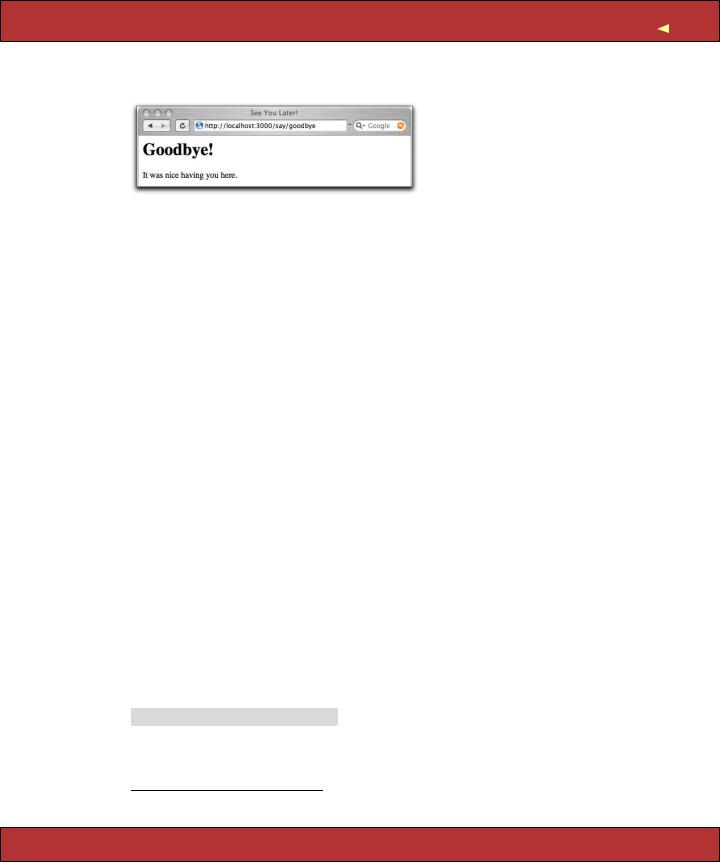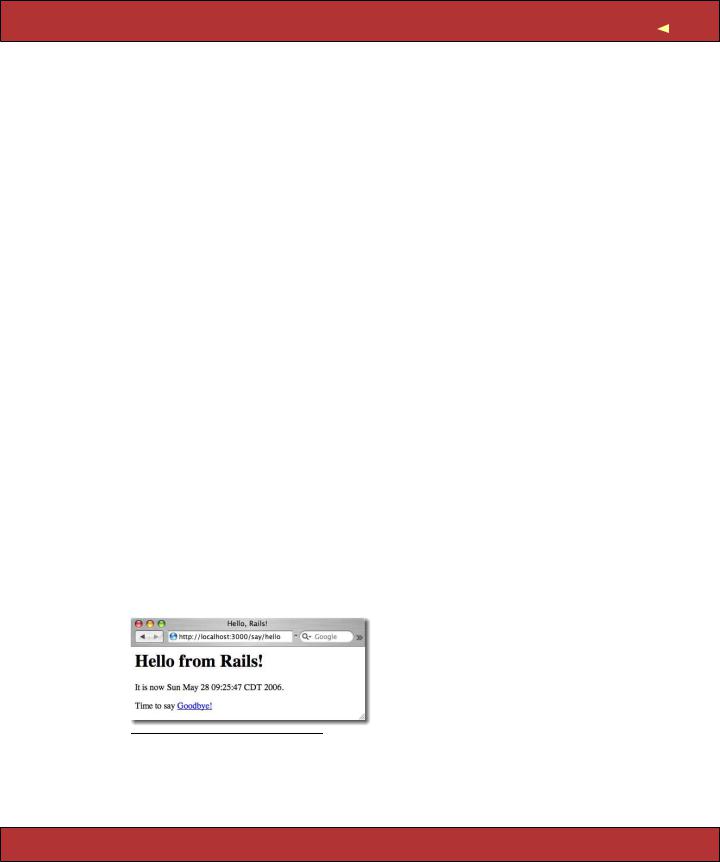
- •Contents
- •Preface to the Second Edition
- •Introduction
- •Rails Is Agile
- •Finding Your Way Around
- •Acknowledgments
- •Getting Started
- •The Architecture of Rails Applications
- •Models, Views, and Controllers
- •Active Record: Rails Model Support
- •Action Pack: The View and Controller
- •Installing Rails
- •Your Shopping List
- •Installing on Windows
- •Installing on Mac OS X
- •Installing on Linux
- •Development Environments
- •Rails and Databases
- •Rails and ISPs
- •Creating a New Application
- •Hello, Rails!
- •Linking Pages Together
- •What We Just Did
- •Building an Application
- •The Depot Application
- •Incremental Development
- •What Depot Does
- •Task A: Product Maintenance
- •Iteration A1: Get Something Running
- •Iteration A2: Add a Missing Column
- •Iteration A3: Validate!
- •Iteration A4: Prettier Listings
- •Task B: Catalog Display
- •Iteration B1: Create the Catalog Listing
- •Iteration B4: Linking to the Cart
- •Task C: Cart Creation
- •Sessions
- •Iteration C1: Creating a Cart
- •Iteration C2: A Smarter Cart
- •Iteration C3: Handling Errors
- •Iteration C4: Finishing the Cart
- •Task D: Add a Dash of AJAX
- •Iteration D1: Moving the Cart
- •Iteration D3: Highlighting Changes
- •Iteration D4: Hide an Empty Cart
- •Iteration D5: Degrading If Javascript Is Disabled
- •What We Just Did
- •Task E: Check Out!
- •Iteration E1: Capturing an Order
- •Task F: Administration
- •Iteration F1: Adding Users
- •Iteration F2: Logging In
- •Iteration F3: Limiting Access
- •Iteration F4: A Sidebar, More Administration
- •Task G: One Last Wafer-Thin Change
- •Generating the XML Feed
- •Finishing Up
- •Task T: Testing
- •Tests Baked Right In
- •Unit Testing of Models
- •Functional Testing of Controllers
- •Integration Testing of Applications
- •Performance Testing
- •Using Mock Objects
- •The Rails Framework
- •Rails in Depth
- •Directory Structure
- •Naming Conventions
- •Logging in Rails
- •Debugging Hints
- •Active Support
- •Generally Available Extensions
- •Enumerations and Arrays
- •String Extensions
- •Extensions to Numbers
- •Time and Date Extensions
- •An Extension to Ruby Symbols
- •with_options
- •Unicode Support
- •Migrations
- •Creating and Running Migrations
- •Anatomy of a Migration
- •Managing Tables
- •Data Migrations
- •Advanced Migrations
- •When Migrations Go Bad
- •Schema Manipulation Outside Migrations
- •Managing Migrations
- •Tables and Classes
- •Columns and Attributes
- •Primary Keys and IDs
- •Connecting to the Database
- •Aggregation and Structured Data
- •Miscellany
- •Creating Foreign Keys
- •Specifying Relationships in Models
- •belongs_to and has_xxx Declarations
- •Joining to Multiple Tables
- •Acts As
- •When Things Get Saved
- •Preloading Child Rows
- •Counters
- •Validation
- •Callbacks
- •Advanced Attributes
- •Transactions
- •Action Controller: Routing and URLs
- •The Basics
- •Routing Requests
- •Action Controller and Rails
- •Action Methods
- •Cookies and Sessions
- •Caching, Part One
- •The Problem with GET Requests
- •Action View
- •Templates
- •Using Helpers
- •How Forms Work
- •Forms That Wrap Model Objects
- •Custom Form Builders
- •Working with Nonmodel Fields
- •Uploading Files to Rails Applications
- •Layouts and Components
- •Caching, Part Two
- •Adding New Templating Systems
- •Prototype
- •Script.aculo.us
- •RJS Templates
- •Conclusion
- •Action Mailer
- •Web Services on Rails
- •Dispatching Modes
- •Using Alternate Dispatching
- •Method Invocation Interception
- •Testing Web Services
- •Protocol Clients
- •Secure and Deploy Your Application
- •Securing Your Rails Application
- •SQL Injection
- •Creating Records Directly from Form Parameters
- •Avoid Session Fixation Attacks
- •File Uploads
- •Use SSL to Transmit Sensitive Information
- •Knowing That It Works
- •Deployment and Production
- •Starting Early
- •How a Production Server Works
- •Repeatable Deployments with Capistrano
- •Setting Up a Deployment Environment
- •Checking Up on a Deployed Application
- •Production Application Chores
- •Moving On to Launch and Beyond
- •Appendices
- •Introduction to Ruby
- •Classes
- •Source Code
- •Resources
- •Index
- •Symbols

LINKING PAGES TOGETHER |
56 |
This isn’t the whole story—Rails gives you lots of opportunities to override this basic workflow (and we’ll be taking advantage of these shortly). As it stands, our story illustrates convention over configuration, one of the fundamental parts of the philosophy of Rails. By providing convenient defaults and by applying certain conventions, Rails applications are typically written using little or no external configuration—things just knit themselves together in a natural way.
4.3Linking Pages Together
It’s a rare web application that has just one page. Let’s see how we can add another stunning example of web design to our Hello, World! application.
Normally, each style of page in your application will correspond to a separate view. In our case, we’ll also use a new action method to handle the page (although that isn’t always the case, as we’ll see later in the book). We’ll use the same controller for both actions. Again, this needn’t be the case, but we have no compelling reason to use a new controller right now.
We already know how to add a new view and action to a Rails application. To add the action, we define a new method in the controller. Let’s call this action goodbye. Our controller now looks like the following.
Download work/demo3/app/controllers/say_controller.rb
class SayController < ApplicationController def hello
@time = Time.now end
def goodbye end
end
Next we have to create a new template in the directory app/views/say. This time it’s called goodbye.rhtml, because by default templates are named after the associated actions.
Download work/demo3/app/views/say/goodbye.rhtml
<html>
<head>
<title>See You Later!</title> </head>
<body> <h1>Goodbye!</h1> <p>
It was nice having you here.
</p>
</body>
</html>
Report erratum

LINKING PAGES TOGETHER |
57 |
Fire up our trusty browser again, but this time point to our new view using the URL http://localhost:3000/say/goodbye. You should see something like this.
Now we need to link the two screens. We’ll put a link on the hello screen that takes us to the goodbye screen, and vice versa. In a real application we might want to make these proper buttons, but for now we’ll just use hyperlinks.
We already know that Rails uses a convention to parse the URL into a target controller and an action within that controller. So a simple approach would be to adopt this URL convention for our links. The file hello.rhtml would contain the following.
<html>
...
<p>
Say <a href="/say/goodbye">Goodbye</a>!
</p>
...
And the file goodbye.rhtml would point the other way.
<html>
...
<p>
Say <a href="/say/hello">Hello</a>!
</p>
...
This approach would certainly work, but it’s a bit fragile. If we were to move our application to a different place on the web server, the URLs would no longer be valid. It also encodes assumptions about the Rails URL format into our code; it’s possible a future version of Rails might change this.
Fortunately, these aren’t risks we have to take. Rails comes with a bunch of helper methods that can be used in view templates. Here, we’ll use the helper method link_to, which creates a hyperlink to an action.6 Using link_to, hello.rhtml becomes
Download work/demo4/app/views/say/hello.rhtml
<html>
<head>
<title>Hello, Rails!</title> </head>
6. The link_to method can do a lot more than this, but let’s take it gently for now....
Report erratum

LINKING PAGES TOGETHER |
58 |
<body>
<h1>Hello from Rails!</h1> <p>
It is now <%= @time %>.
</p>
<p>
Time to say
<%= link_to "Goodbye!", :action => "goodbye" %>
</p>
</body>
</html>
There’s a link_to call within an ERb <%=...%> sequence. This creates a link to a URL that will invoke the goodbye action. The first parameter in the call to link_to is the text to be displayed in the hyperlink, and the next parameter tells Rails to generate the link to the goodbye action. As we don’t specify a controller, the current one will be used.
Let’s stop for a minute to consider how we generated the link. We wrote
link_to "Goodbye!", :action => "goodbye"
First, link_to is a method call. (In Rails, we call methods that make it easier to write templates helpers.) If you come from a language such as Java, you might be surprised that Ruby doesn’t insist on parentheses around method parameters. You can always add them if you like.
The :action part is a Ruby symbol. You can think of the colon as meaning the thing named..., so :action means the thing named action.7 The => "goodbye" associates the string goodbye with the name action. In effect, this gives us keyword parameters for methods. Rails makes extensive use of this facility— whenever a method takes a number of parameters and some of those parameters are optional, you can use this keyword parameter facility to give those parameters values.
OK. Back to the application. If we point our browser at our hello page, it will now contain the link to the goodbye page, as shown here.
7. Symbols probably cause more confusion than any other language feature when folks first come to Ruby. We’ve tried many different explanations—no single explanation works for everyone. For now, you can just think of a Ruby symbol as being like a constant string but one without all the string methods. It’s the name tag, not the person.
Report erratum

WHAT WE JUST DID |
59 |
We can make the corresponding change in goodbye.rhtml, linking it back to the initial hello page.
Download work/demo4/app/views/say/goodbye.rhtml
<html>
<head>
<title>See You Later!</title> </head>
<body> <h1>Goodbye!</h1> <p>
It was nice having you here.
</p>
<p>
Say <%= link_to "Hello", :action => "hello" %> again.
</p>
</body>
</html>
4.4What We Just Did
In this chapter we constructed a toy application. Doing so showed us
•how to create a new Rails application and how to create a new controller in that application,
•how Rails maps incoming requests into calls on your code,
•how to create dynamic content in the controller and display it via the view template, and
•how to link pages together.
This is a great foundation. Now let’s start building real applications.
Playtime
Here’s some stuff to try on your own.
•Write a page for the say application that illustrates the looping you can do in ERb.
•Experiment with adding and removing the minus sign at the end of the ERb <%= %> sequence (i.e., changing %> into -%>, and vice versa. Use your browser’s View → Source option to see the difference.
•A call to the following Ruby method returns a list of all the files in the current directory.
@files = Dir.glob('*')
Report erratum

WHAT WE JUST DID |
60 |
Use it to set an instance variable in a controller action, and then write the corresponding template that displays the filenames in a list on the browser.
Hint: in the ERb examples, we saw how to iterate n times. You can iterate over a collection using something like
<% for file in @files %> file name is: <%= file %>
<% end %>
You might want to use a <ul> for the list.
(You’ll find hints at http://wiki.pragprog.com/cgi-bin/wiki.cgi/RailsPlayTime)
Cleaning Up
Maybe you’ve been following along, writing the code in this chapter. If so, the chances are that the application is still running on your computer. When we start coding our next application in 10 pages or so, we’ll get a conflict the first time we run it, because it will also try to use your computer’s port 3000 to talk with the browser. Now would be a good time to stop the current application by pressing control-C in the window you used to start it.
Report erratum
